How San hunters use beetles to
poison their arrows
San ('bushman') hunters use lightly constructed bows and
arrows in their hunting which means that the injury inflicted by the arrow is usually
insufficient to subdue large prey unless it is supplemented by a poison that has
been applied to the arrow. A variety of poisons have been used by the various
groups of hunters. Some use plant-derived substances or toxins derived
from poisonous snakes. However, in the northern Kalahari, the most commonly used
poisonous substance for arrows is that derived from the larva and pupae of chrysomelid
beetles in the genus Diamphidia.
|
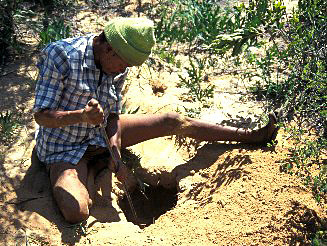 |
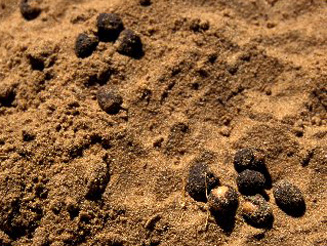 |
|
Digging up cocoons of Diamphidia
beetles in the vicinity of their host plant Commiphora sp. The
cocoons are usually buried 0.5 -1 m below ground surface. |
Each cocoon usually contains a
larva in an arrested stage of development prior to pupation. Larvae can
stay in this dormant stage for several years. |
|
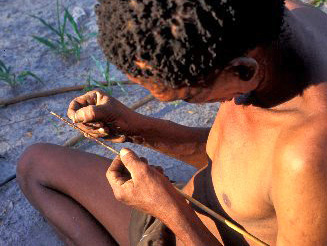 |
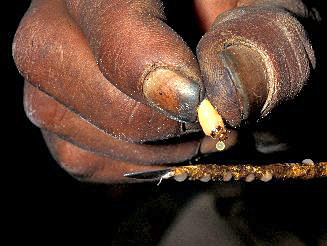 |
|
A
San hunter squeezing the haemolymph of a beetle larva on to an arrow. Up
to 10 larvae may be applied to one arrow. The poison is applied to the
foreshaft behind the point and not to the point itself, evidently to avoid
accidental poisoning to the hunter from being scratched by the arrow
point. The poison is a protein and becomes less potent with time but
generally can retain its toxicity for up to a year. |
A drop of haemolymph of the Diamphidia
vittatipennis larva is squeezed from the larva onto the arrow shaft.
|
|
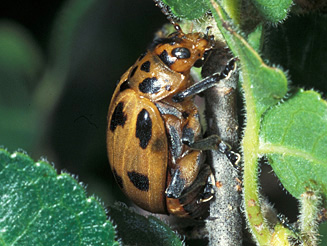 |
|
|
The adult of Diamphidia
vittatipennis. Read up more about its life
cycle. |
|
Two main species of Diamphidia are
used namely Diamphidia nigroornata (host plant Commiphora angolensis)
and Diamphidia vittatipennis (host plant Commiphora africana). In
addition, larvae of the chrysomelid beetle Polyclada flexuosa (host plant
Sclerocarya caffra) can also be used as a toxin. Each of these three
species is also parasitised by carabid beetles in the genus Lebistina. The
Lebistina larvae, by attaching themselves to full-grown Diamphidia and
Polyclada larvae, remain with them when they make their cocoon. Inside
the cocoon, they feed on blood and
soft parts of the chrysomeld larvae, eventually killing them. The Lebistina
larvae are also toxic, in fact the San hunters evidently find them more toxic
than the chrysomelid larvae and favour these parasitic larvae for their arrows.
There are three main ways in which the poison may be
applied to the arrows:
-
Squeezing the contents of larvae/pupae directly on to
the arrows (see above photos). This might be followed by drying the arrows
over a fire.
-
Making a mixture of beetle larvae/pupae plus plant
juice plus spit and then applying it to the arrows. The plant juice acts as
an adhesive.
-
Drying the larvae/pupae in the sun, grinding them into
powder and then mixing the powder with plant juices. This mixture is then
applied to the arrows.
After shooting an animal with an arrow, the hunters then
follow its spoor until the poison subdues it which can be within a few hours but
which can take 4-5 days in the case of large prey such as giraffe. A wounded
animal can evidently travel 40-70 miles (64-112 km) before slowing down and
finally falling down dead. Noli (1993) comments on the fact that this system of
hunting animals is very time consuming and in fact would be much more efficient
if more powerful bows with more injuring arrows were used. There are various
reasons why they might not have adopted more powerful bows including the
possibility that hunting is more than just about survival but also about a
culture and sport with rules and status.
It is interesting that the toxin from these beetle
larvae/pupae (called diamphidia toxin) in non-toxic to mammals by ingestion and
is only toxic after it enters the blood stream. This is puzzling because it then
raises the question as to how this toxin provides protection to the beetle larva
from predators and parasitoids. Perhaps this non-toxicity by ingestion does not
apply to non-mammals.
References
-
Koch, C. 1958. Preliminary notes on the
coleopterological aspect of the arrow poison of the bushmen. Pamphlet of
the South African Biological Society 20: 49-54.
-
Noli, H.D. 1993. A Technical Investigation
into the Material Evidence for Archery in the Archaeological and
Ethnographical Record in Southern Africa. Unpublished Ph.D. thesis,
University of Cape Town, 252 pages.
-
Shaw, E.M., Woolley, P.L. & Rae, F.A.
1963. Bushman arrow poisons. Cimbebasia 7(2): 2-41.
-
Woollard, J.M.R., Fuhrman, F.A. & Mosher,
H.S. 1984. The bushman arrow toxin, diamphidia toxin: isolation from pupae
of Diamphidia nigro-ornata. Toxicon 22: 937-946.
Text and photographs by Hamish Robertson |
